![[Previous]](../../../buttons/fprev.png)
![[Next]](../../../buttons/fnext.png)
DTC P0096: Intake
Air Temperature Circuit Range/Performance Problem (sensor 2)
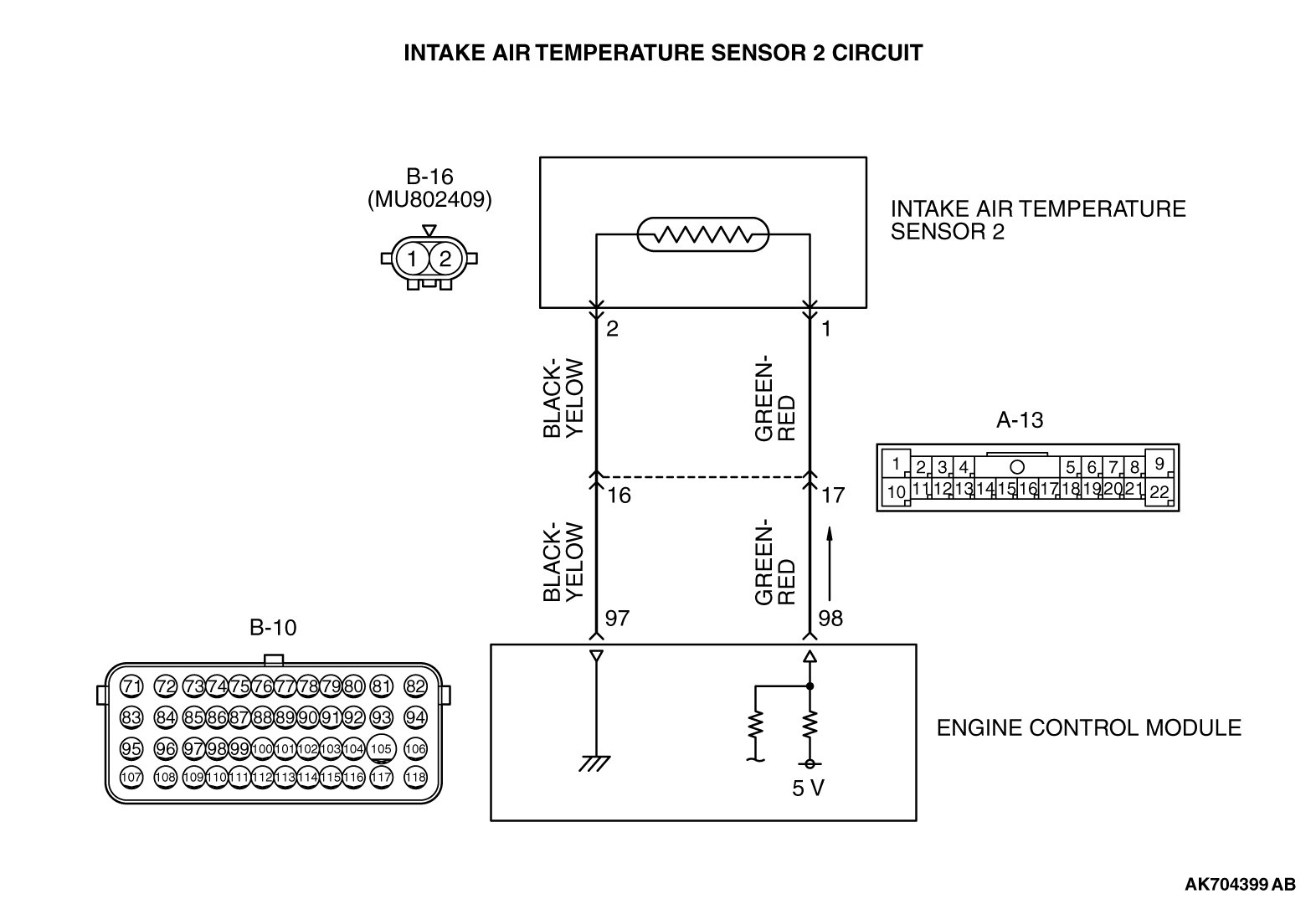
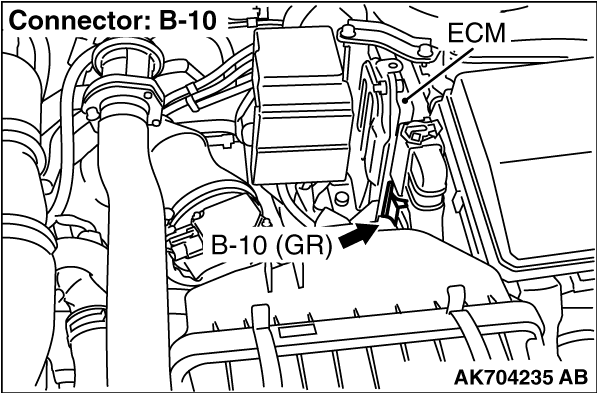

CIRCUIT OPERATION
- Approximately 5 volts are applied to the intake air temperature
sensor 2 output terminal (terminal No. 1) from the ECM (terminal No. 98) via the resistor in
the ECM. The ground terminal (terminal No. 2) is grounded with ECM (terminal No. 97).
- The intake air temperature sensor 2 is a negative temperature coefficient type of
resistor. When the intake air temperature rises, the resistance decreases.
- The intake air temperature sensor 2 output voltage increases when the resistance
increases and decreases when the resistance decreases.
TECHNICAL DESCRIPTION
- The intake air temperature sensor 2 converts the intake
air temperature to a voltage.
- The ECM checks whether this voltage is within a specified range.
DESCRIPTIONS OF MONITOR METHODS
Intake air temperature sensor 2 output voltage does not
change when specified go/stop operations are repeated.
MONITOR EXECUTION
MONITOR EXECUTION CONDITIONS (Other monitor and Sensor)
Other Monitor (There is no temporary DTC stored in memory
for the item monitored below)
Sensor (The sensor below is determined to be normal)
- Engine coolant temperature sensor
DTC SET CONDITIONS
Logic Flow Chart
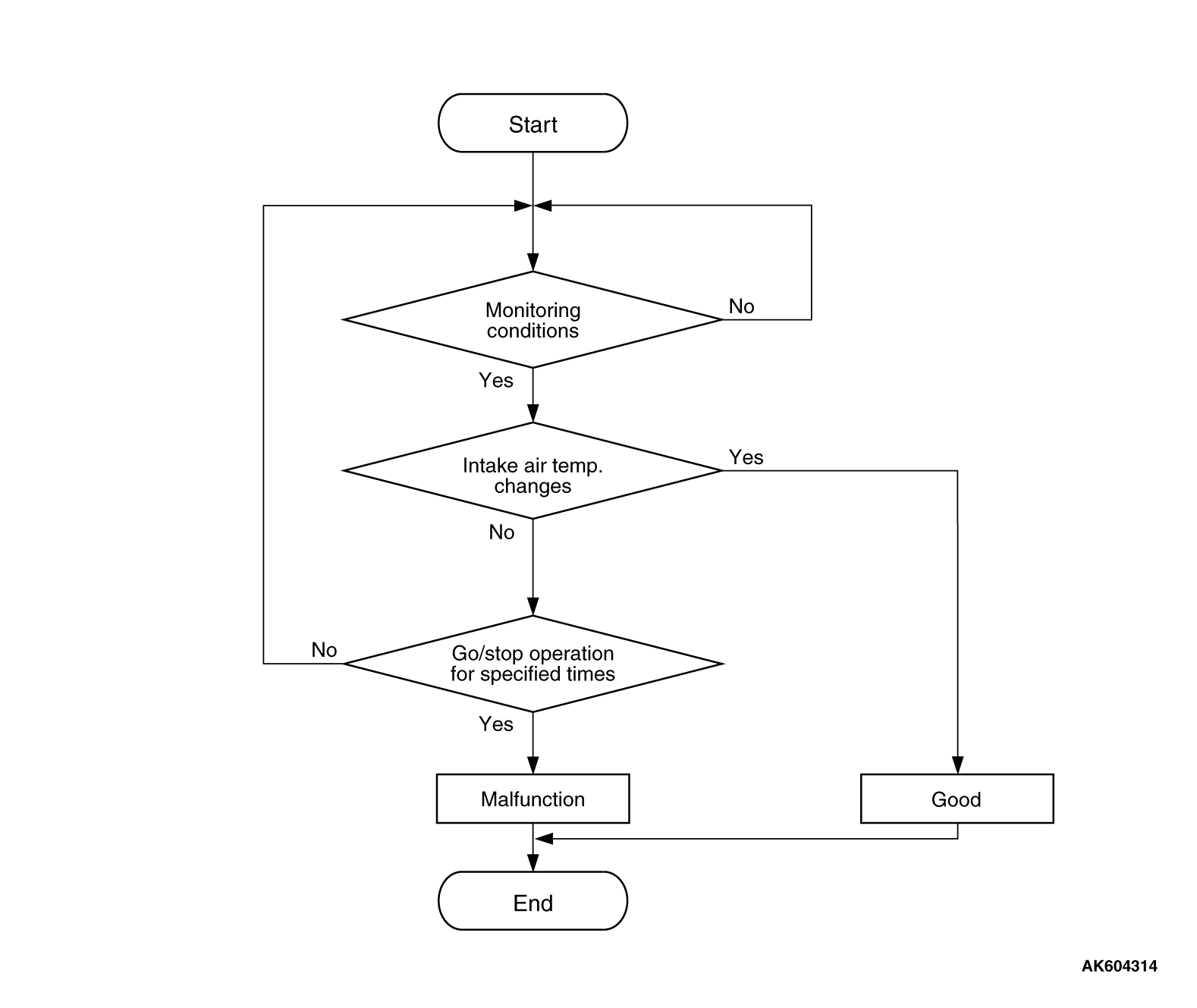
Check Conditions
- Engine coolant temperature is higher than 76°C (169°F).
- Repeat 2 or more times: drive*1, stop*2.
Drive*1: vehicle speed higher
than 50 km/h (31 mph) lasting a total of 60 seconds or more.
Stop*2: vehicle speed lower than 1.5 km/h (1.0 mph)
lasting 30 seconds or more.
Judgement Criterion
- Changes in the intake air temperature is lower than 1°C (1.8°F).
FAIL-SAFE AND BACKUP FUNCTION
- Control as if the intake air temperature in the intake
manifold is 25 °C.
OBD-II DRIVE CYCLE PATTERN
Refer to Diagnostic Function - OBD-II Drive Cycle - Pattern
7  .
.
TROUBLESHOOTING HINTS (The most likely causes for this code to be set are:)
- Intake air temperature sensor 2 failed.
- Harness damage or connector damage.
- ECM failed.
|
|
STEP 1. Using scan tool MB991958, check data list item DE:
Intake Air Temperature Sensor 2.
|
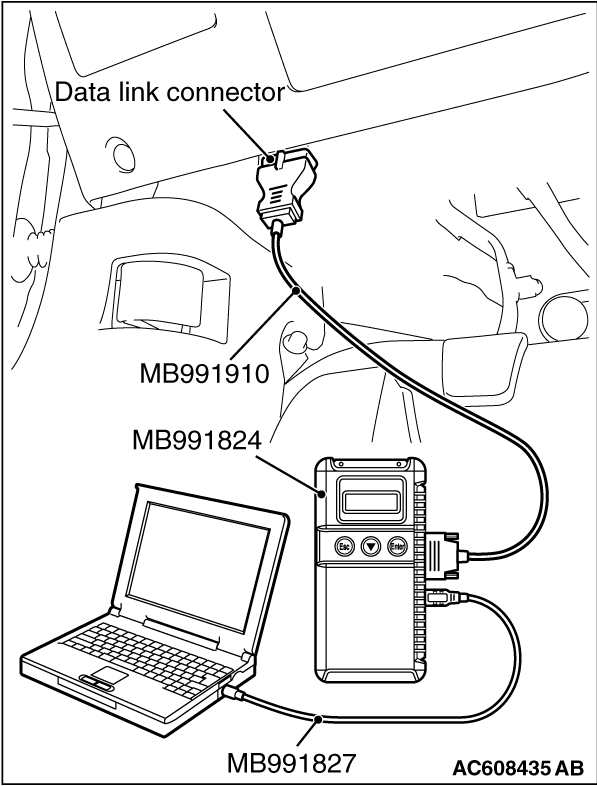
|
| caution |
To prevent damage to scan tool MB991958, always turn the ignition switch to the "LOCK"
(OFF) position before connecting or disconnecting scan tool MB991958.
|
(1)Connect scan tool MB991958 to the data link connector.
(2)Remove the intake air temperature sensor 2 from the intake manifold.
(3)Turn the ignition switch to the "ON" position.
(4)Set scan tool MB991958 to the data reading mode for item DE, Intake Air Temperature
Sensor 2.
|
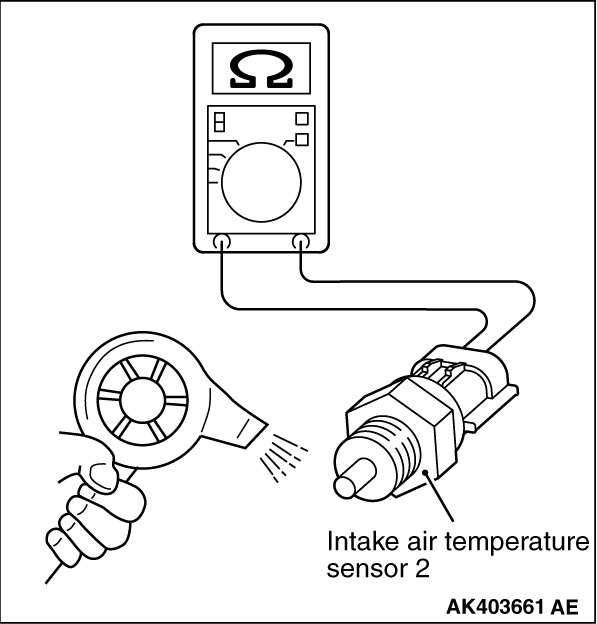
|
(5)Heating the sensor using a hair drier.
- The indicated temperature increases.
| note |
Do not allow it to increase over 80°C (176°F).
|
(6)Turn the ignition switch to the "LOCK" (OFF) position.
(7)Attach the intake air temperature sensor 2.
Q.
Is the sensor operating properly?
 It can be assumed that this malfunction is intermittent. Refer to GROUP 00, How
to Use Troubleshooting/Inspection Service Points - How to Cope with Intermittent
Malfunctions It can be assumed that this malfunction is intermittent. Refer to GROUP 00, How
to Use Troubleshooting/Inspection Service Points - How to Cope with Intermittent
Malfunctions  . .
 Go to Step 2. Go to Step 2.
|
|
|
STEP 2. Check the intake air temperature sensor 2.
|
|
|
(1)Disconnect the intake air temperature sensor 2 connector B-16.
|
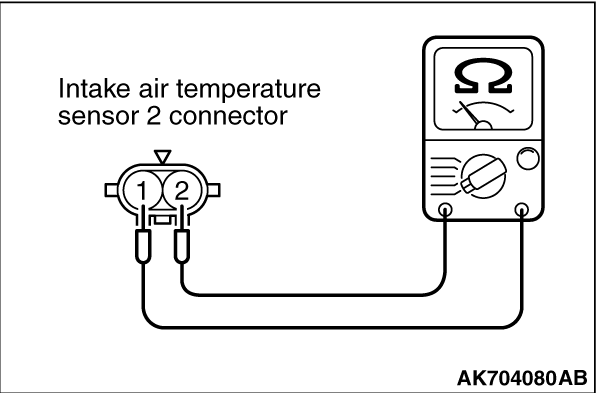
|
(2)Measure the resistance between intake air temperature sensor 2 side connector terminal
No. 1 and No. 2.
|

|
(3)Measure resistance while heating the sensor using a hair drier.
Standard value:
13 - 18 kΩ [at -20°C (-4°F)]
5.1 - 6.9 kΩ [at 0°C (32°F)]
2.0 - 3.0 kΩ [at 20°C (68°F)]
0.9 - 1.5 kΩ [at 40°C (104°F)]
0.40 - 0.78 kΩ [at 60°C (140°F)]
0.23 - 0.42 kΩ [at 80°C (176°F)]
Q.
Is the measured resistance at the standard value?
 Go to Step 3. Go to Step 3.
 Replace the intake air temperature sensor 2. Then go to Step 9. Replace the intake air temperature sensor 2. Then go to Step 9.
|
|
|
STEP 3. Check harness connector B-16 at the intake air temperature
sensor 2 for damage.
|
|
|
Q.
Is the harness connector in good condition?
|
|
|
 Go to Step 4. Go to Step 4.
|
|
|
|
|
|
 Repair or replace it. Refer to GROUP 00E, Harness Connector Inspection Repair or replace it. Refer to GROUP 00E, Harness Connector Inspection  .
Then go to Step 9. .
Then go to Step 9.
|
|
|
|
|
|
STEP 4. Check the continuity at intake air temperature sensor 2 harness
side connector B-16.
|
|
|
(1)Disconnect the connector B-16 and measure at the harness side.
|
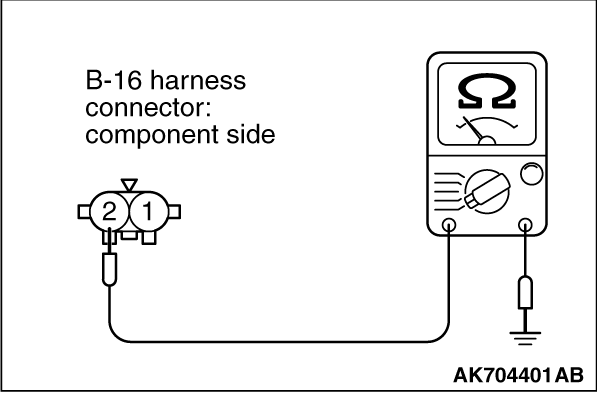
|
(2)Check for the continuity between terminal No. 2 and ground.
- Continuity (2 ohms or less)
Q.
Does continuity exist?
 Go to Step 7. Go to Step 7.
 Go to Step 5. Go to Step 5.
|
|
|
STEP 5. Check harness connector B-10 at ECM for damage.
|
|
|
Q.
Is the harness connector in good condition?
|
|
|
 Go to Step 6. Go to Step 6.
|
|
|
|
|
|
 Repair or replace it. Refer to GROUP 00E, Harness Connector Inspection Repair or replace it. Refer to GROUP 00E, Harness Connector Inspection  .
Then go to Step 9. .
Then go to Step 9.
|
|
|
|
|
|
STEP 6. Check for harness damage between intake air temperature sensor
2 connector B-16 (terminal No. 2) and ECM connector B-10 (terminal No. 97).
|
|
|
| note |
Check harness after checking intermediate connector A-13. If intermediate connector is
damaged, repair or replace it. Repair to GROUP 00E, Harness Connector Inspection  .
Then go to Step 9. .
Then go to Step 9.
|
|
|
|
Q.
Is the harness wire in good condition?
|
|
|
 Replace the ECM. When the ECM is replaced, register the ID code. Refer to GROUP
42B, ID Code Registration Necessity Judgment Table <Vehicles with KOS> Replace the ECM. When the ECM is replaced, register the ID code. Refer to GROUP
42B, ID Code Registration Necessity Judgment Table <Vehicles with KOS>  or
GROUP 42C, ID Codes Registration Judgment Table <Vehicles with WCM> or
GROUP 42C, ID Codes Registration Judgment Table <Vehicles with WCM>  .
Then go to Step 9. .
Then go to Step 9.
|
|
|
|
|
|
 Repair it. Then go to Step 9. Repair it. Then go to Step 9.
|
|
|
|
|
|
STEP 7. Check harness connector B-10 at ECM for damage.
|
|
|
Q.
Is the harness connector in good condition?
|
|
|
 Go to Step 8. Go to Step 8.
|
|
|
|
|
|
 Repair or replace it. Refer to GROUP 00E, Harness Connector Inspection Repair or replace it. Refer to GROUP 00E, Harness Connector Inspection  .
Then go to Step 9. .
Then go to Step 9.
|
|
|
|
|
|
STEP 8. Check for harness damage between intake air temperature sensor
2 connector B-16 (terminal No. 1) and ECM connector B-10 (terminal No. 98).
|
|
|
| note |
Check harness after checking intermediate connector A-13. If intermediate connector is
damaged, repair or replace it. Repair to GROUP 00E, Harness Connector Inspection  .
Then go to Step 9. .
Then go to Step 9.
|
|
|
|
Q.
Is the harness wire in good condition?
|
|
|
 Replace the ECM. When the ECM is replaced, register the ID code. Refer to GROUP
42B, ID Code Registration Necessity Judgment Table <Vehicles with KOS> Replace the ECM. When the ECM is replaced, register the ID code. Refer to GROUP
42B, ID Code Registration Necessity Judgment Table <Vehicles with KOS>  or
GROUP 42C, ID Codes Registration Judgment Table <Vehicles with WCM> or
GROUP 42C, ID Codes Registration Judgment Table <Vehicles with WCM>  .
Then go to Step 9. .
Then go to Step 9.
|
|
|
|
|
|
 Repair it. Then go to Step 9. Repair it. Then go to Step 9.
|
|
|
|
|
|
STEP 9. Test the OBD-II drive cycle.
|
|
|
(1)Carry out a test drive with the drive cycle pattern. Refer to Diagnostic Function - OBD-II
Drive Cycle - Pattern 7  . .
|
|
|
(2)Check the diagnostic trouble code (DTC).
|
|
|
 Retry the troubleshooting. Retry the troubleshooting.
|
|
|
|
|
|
 The inspection is complete. The inspection is complete.
|
|
|
|
 .
.![[Previous]](../../../buttons/fprev.png)
![[Next]](../../../buttons/fnext.png)




 .
.
 It can be assumed that this malfunction is intermittent. Refer to GROUP 00, How
to Use Troubleshooting/Inspection Service Points - How to Cope with Intermittent
Malfunctions
It can be assumed that this malfunction is intermittent. Refer to GROUP 00, How
to Use Troubleshooting/Inspection Service Points - How to Cope with Intermittent
Malfunctions  .
. Go to Step 2.
Go to Step 2.

 Go to Step 3.
Go to Step 3. Replace the intake air temperature sensor 2. Then go to Step 9.
Replace the intake air temperature sensor 2. Then go to Step 9. Go to Step 4.
Go to Step 4. Repair or replace it. Refer to GROUP 00E, Harness Connector Inspection
Repair or replace it. Refer to GROUP 00E, Harness Connector Inspection  .
Then go to Step 9.
.
Then go to Step 9.
 Go to Step 7.
Go to Step 7. Go to Step 5.
Go to Step 5. Go to Step 6.
Go to Step 6. Repair or replace it. Refer to GROUP 00E, Harness Connector Inspection
Repair or replace it. Refer to GROUP 00E, Harness Connector Inspection  .
Then go to Step 9.
.
Then go to Step 9. Replace the ECM. When the ECM is replaced, register the ID code. Refer to GROUP
42B, ID Code Registration Necessity Judgment Table <Vehicles with KOS>
Replace the ECM. When the ECM is replaced, register the ID code. Refer to GROUP
42B, ID Code Registration Necessity Judgment Table <Vehicles with KOS>  or
GROUP 42C, ID Codes Registration Judgment Table <Vehicles with WCM>
or
GROUP 42C, ID Codes Registration Judgment Table <Vehicles with WCM>  .
Then go to Step 9.
.
Then go to Step 9. Repair it. Then go to Step 9.
Repair it. Then go to Step 9. Go to Step 8.
Go to Step 8. Repair or replace it. Refer to GROUP 00E, Harness Connector Inspection
Repair or replace it. Refer to GROUP 00E, Harness Connector Inspection  .
Then go to Step 9.
.
Then go to Step 9. Replace the ECM. When the ECM is replaced, register the ID code. Refer to GROUP
42B, ID Code Registration Necessity Judgment Table <Vehicles with KOS>
Replace the ECM. When the ECM is replaced, register the ID code. Refer to GROUP
42B, ID Code Registration Necessity Judgment Table <Vehicles with KOS>  or
GROUP 42C, ID Codes Registration Judgment Table <Vehicles with WCM>
or
GROUP 42C, ID Codes Registration Judgment Table <Vehicles with WCM>  .
Then go to Step 9.
.
Then go to Step 9. Repair it. Then go to Step 9.
Repair it. Then go to Step 9. .
. Retry the troubleshooting.
Retry the troubleshooting. The inspection is complete.
The inspection is complete.